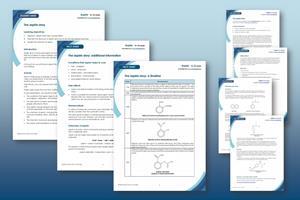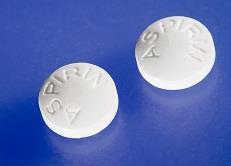The history of aspirin and other medicines dealing with pain, fever or inflammation reveals many interesting points about scientific methodology and the interaction of people and society with technology
This resource accompanies the article From plant to pill in Education in Chemistry which delves into the science behind natural remedies and the research and development that brings medicines to the market.
-

Download this
Download this research and presentation activity for groups of 16–18 year old learners including student instructions, a timeline of the development of aspirin, additional supporting information and teacher notes including peer assessment criteria and extra information on alternative analgesics.
Learning objectives
- Research, design and make a presentation.
- Describe the discovery of aspirin and how its use has developed over time.
- Explain the chemistry of aspirin.
Introduction
Nearly all of us have used aspirin at some time in our lives, but not many of us know that for hundreds of years a related compound from willow bark was used to relieve pain and treat fevers. Records indicate its use from ancient times; at least 2500 years BC.
In this activity, learners will find out about the discovery and use of aspirin and present their findings as a poster, presentation or video.
Timeline
| Date | Development |
|---|---|
|
1763 |
Edward Stone (a clergyman) read a paper to the Royal Society of London: ‘An account of the success of the bark of the willow in the cure of agues’. He had collected observations from around the country on the effect of willow bark on the relief of fever due to agues (malaria). |
|
1830s |
A Scottish physician found that extracts of willow bark relieved symptoms of acute rheumatism. |
|
1840s |
Organic chemists working with willow bark and flowers of the meadowsweet plant, spirea, isolated and identified the active ingredient as salicin (salix = Latin word for willow). |
|
1870 |
Marceli von Nencki of Basle demonstrated that salicin was converted into salicylic acid in the body. Salicylic acid was then given to patients with fevers and their symptoms were relieved. However, the compound caused severe irritation of the lining of the mouth, gullet and stomach. |
|
1875 |
Chemists made sodium salicylate and gave that to doctors to try on their patients. It still worked to help reduce pain and fever and did lessen the irritation but it tasted awful! In the large doses used for treating rheumatism, sodium salicylate frequently caused the patient to vomit. |
|
1890s |
Felix Hoffmann of the Bayer Company in Germany made aspirin, which was found to have good medicinal properties, low membrane irritation and a reasonable taste. This followed the publication of news about the temperature-reducing properties of acetanilide which immediately spurred a chemist at Bayer’s dyeworks to make some derivatives: He called the new medicine aspirin (‘a’ for acetyl – the systematic name of the compound at the time was acetylsalicylic acid and ‘spir’ for spirea, the meadowsweet plant). Nowadays, chemists use the systematic name, ethanoyl, instead of acetyl but the trivial name acetyl is still very common. |
|
1898 |
Aspirin was sent for clinical trials, Bayer manufactured the medicine and patented the process. |
|
1915 |
During World War I, the British wanted aspirin, but it was made by the Germans (Bayer & Co). So the British government offered a £20,000 reward to anyone who could develop a workable manufacturing process. This was achieved by George Nicholas, a Melbourne pharmacist, who subsequently gave his tablet the name ‘Aspro’. |
|
1932 |
Invention of the gastroscope leads to evidence that aspirin was associated with irritation of the lining of the stomach. |
|
1956 |
Introduction of paracetamol (Tylenol™ in the US) as an alternative analgesic that did not have the same side-effects as aspirin. |
|
1974 |
The International Aspirin Foundation was founded to increase knowledge and understanding of aspirin. |
|
1982 |
Introduction of ibuprofen, which further impacts sales of aspirin as an analgesic . |
|
1982 |
The Nobel Prize in physiology or medicine was awarded for work on prostaglandins and related compounds. John Vare, who shared the prize with two Swedes, discovered that aspirin and some other painkillers and anti-inflammatory drugs (such as ibuprofen) inhibit a key enzyme in the prostaglandin synthetic pathway. They therefore stop your body making prostaglandins, some of which stimulate pain receptors and cause inflammation. For more information see: nobelprize.org/prizes/medicine/1982/press-release/ |
|
1986 |
Aspirin is no longer recommended to be given to children due to evidence of a link to Reye’s syndrome – a rare disorder that can cause severe liver and brain damage in children and young adults. |
|
1988 |
Cardiologists start using aspirin with patients at risk of having a heart attack. An academic study makes a link between colon cancer and rectal cancer prevention and aspirin. |
|
1990s |
More than 10 million kilograms of aspirin are made in the US each year! |
|
2002 |
A paper was published in the BMJ confirming aspirin’s role in preventing death, heart attacks and stroke in high-risk patients: bmj.com/content/324/7329/71 |
|
2015 |
US Preventative Services Task Force recommends aspirin for the prevention of cardiovascular disease and cancer. |
|
2019 |
The International Federation of Gynaecology and Obstetrics recommend that women who are at high risk of pre-eclampsia during pregnancy should take a low dose of aspirin after week 12. |
|
2020 |
According to The Lancet, aspirin is still one of the best options for secondary prevention of cardiovascular disease. |
Teacher notes
The history of aspirin and other medicines dealing with pain, fever or inflammation reveals many interesting points about scientific methodology and the interaction of people and society with technology. One overriding theme that emerges when looking at the development of medicines is the importance of sharing information and cooperation in research. Time and again discoveries in one part of the world have been published, but not developed fully until another person reads and uses the information in another time and place.
The emphasis in this activity is on learners finding out for themselves and presenting their findings to a suitable audience (LO1). Ask groups of learners to choose the format of their presentation from either a talk, poster or video. Hints and tips for making each type of presentation are included on the student sheet.
Your role is to be supportive and offer advice. The fact sheet gives some background to the conditions treated, side effects, and methods testing new drugs (LO2). There is also a brief outline of some of the chemistry of aspirin (LO3), but learners must find out more than is given to them here (All LOs).
Alternatively, you can set this task as an independent group activity, where learners work on the project in their own time. Learners can then peer assess each other’s work against the success criteria below.
- The conditions that aspirin helps to relieve or cure, including technical terms such as analgesic, antipyretic, anti-inflammatory and myocardial infarction.
- The side effects of aspirin, and the alternative treatments for people who are affected by them.
- How aspirin was developed over the past 260 years, including the achievements of those responsible for the main developments.
- The chemistry involved in developing the medicine in a usable form.
- The nature and importance of clinical trials.
- The overall quality of the presentation.
- The sources of information given.
Differentiation
The fact sheet contains information that can be used to support and guide learners as needed. In addition, a timeline is given in a separate document that teachers can optionally use to support learners who may find it challenging to construct their own from research. Using some or all of the information in the fact sheet will cut down on the research time, allowing learners to concentrate on putting the presentation or poster together.
Resources
Groups will need:
- Internet access for groups to carry out their research.
- Presentation software, such as MS PowerPoint or equivalent for making a presentation.
- Poster paper, glue, scissors and a printer for making a poster.
- Recording equipment and software – eg tablet or mobile phone – for making a video.
More resources
- Read about how academic posters help your learners to understand and explain their work and use the academic posters resource to get the most out of poster activities in your classroom
- Why might budding medics need to study A Level Chemistry to pursue medicine at university? Find out with our article and resource series connecting 16–18 topics with future study pathways.
- Use this class practical to produce aspirin in a microscale esterification reaction using phosphoric acid as a catalyst
- Find out what’s involved in leading a team of 30 chemists who are researching new medicines with this interview with a Director of medicinal chemistry.
Downloads
The aspirin story | student sheet
Handout | PDF, Size 0.17 mbThe aspirin story | teacher notes
Handout | PDF, Size 0.22 mbThe aspirin story | fact sheet
Handout | PDF, Size 0.18 mbThe aspirin story | timeline
Handout | PDF, Size 0.18 mbThe aspirin story | student sheet
Editable handout | Word, Size 0.45 mbThe aspirin story | fact sheet
Editable handout | Word, Size 0.46 mbThe aspirin story | teacher notes
Editable handout | Word, Size 0.47 mbThe aspirin story | timeline
Editable handout | Word, Size 0.46 mb
Additional information
The aspirin story was first published in 1998 as part of the Aspirin book, compiled by David Lewis and edited by Colin Osborne and Maria Pack. A second, fully updated, edition of the book was published in 2003.
This resource was revised and updated in 2023 by Dorothy Warren.
Aspirin book

This book contains eight free-standing activities that can be used singly or as a coherent package in a wide range of teaching and learning situations for both academic and vocational courses.
- 1
 Currently
reading
Currently
reading
The aspirin story
- 3
- 4
- 5
- 6
- 7
- 8
- 9



































No comments yet